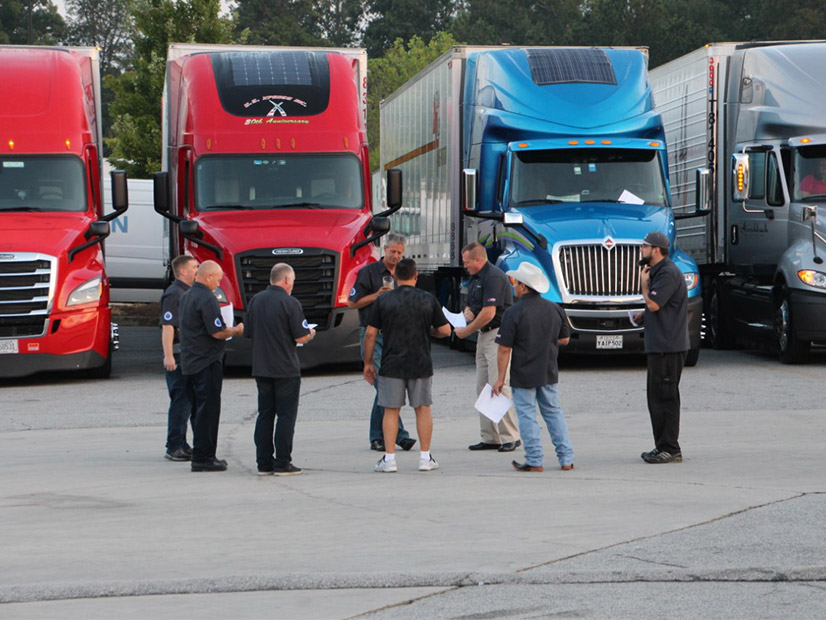The U.S. Department of Energy Thursday unveiled a third funding cycle in its 12-year-old Super Truck initiative to spark innovation in the trucking industry.
In Super Truck 3, DOE is offering $162 million in a competition to improve vehicular electric drive systems, develop better batteries and build charging stations. The agency also wants to fund research into technologies that can increase the efficiency of existing internal combustion engines.
But DOE’s long-term goal is to help the trucking industry get fully electric 18-wheelers on the road.
“We want all kinds of trucks electrified. We want the garbage trucks in your cities. We want the delivery trucks that are being used to drop packages at your home,” said Secretary of Energy Jennifer Granholm at the start of a 45-minute program unveiling the grants and highlighting what DOE’s previous funding has produced. “We want tow trucks that you call in an emergency, really any medium- or heavy-duty truck on the road that runs, we want them to run on alternative or cleaner energy.”
Granholm said getting trucks electrified will be an integral part of the Biden administration’s campaign to reduce carbon emissions.
It will be an enormous undertaking, and Granholm made that clear with some statistics. “We move 73% of domestic freight, about $10.8 trillion dollars of value in shipments, on these big rigs. All told, they support about three million jobs,” she said.
Joel Morrow, a driver for Ploger Transportation, based in Norwalk, Ohio, joined the call, giving some examples of what earlier DOE funding has already produced.
“We have a solar battery [air conditioning] for the truck,” he said from the cab of one of the company’s 40 tractors. “You don’t have to idle the truck [to power the air conditioner]. In the past, you idled [the engine] or had a … diesel motor powered compressor.
“So, we’re not burning diesel fuel while we’re sitting there staying comfortable, and we’re saving the environment by not having to dispose of as many batteries because they actually extend the battery life with the solar panels,” Morrow said.
Another driver, Clark Reed, with Nussbaum Transportation based in Hudson, Ill., said the new truck he was driving Thursday had a newly engineered engine and transmission. He also mentioned solar panels, adding that the panels might be integrated into the all-electric drive trains of the future.
Speaking from his rig parked just off I-80 in Eastern Iowa, Reed said the new technologies that have been added to upgrade diesel rigs require that drivers educate themselves. “All these technologies, like adaptive cruise and lane keep assistant, you can learn to use it … to save fuel, keep yourself safer.”
Both drivers said the new rigs get far better mileage than those they drove 10 years ago — almost double in many cases.
A lot of the incremental technological improvements came about from an initiative, Run on Less, created by the North American Council for Freight Efficiency (NACFE) with the help of earlier DOE grants. Participating trucking companies tested many new technologies aimed at squeezing more miles out of gallon of diesel fuel.
“When we first started testing [solar powered air conditioning], you didn’t see as many solar panels out there, and now they’re becoming accepted,” Clark said. “So being able to test that and prove it. That is something we can bring to market and it can actually improve the efficiency and quality of life.”
Clark said some recent safety improvements, such as forward-facing radar, have also improved efficiency by helping drivers maintain distances from vehicles in front of them. “We’re not braking [as much]. That consumes fuel when you have to re-accelerate,” he said.
“The battery electric truck is the thing that that I’m looking forward to over the next few years, and it starts with smaller urban trucks and will find its way into the larger semis,” said Mike Roeth, executive director of NACFE and a principal with Rocky Mountain Institute.
“We think battery electric and hydrogen fuel cells as they continue to be developed … will be the predominant [technologies] as we enter into the 2040, 2050 carbon-free” era, he said.
NACFE’s Run on Less series, created in 2016, is “a place for the best of the best to demonstrate what they are doing around high efficiency,” Roeth said. By 2017, participating drivers had driven over 100,000 miles. NACFE and RMI used the resulting data to produce 75 videos, which so far have garnered over 70,000 on-line views.
Today, Run on Less is testing electric rigs with 13 fleets and truck builders deploying all-electric trucks across North America.






